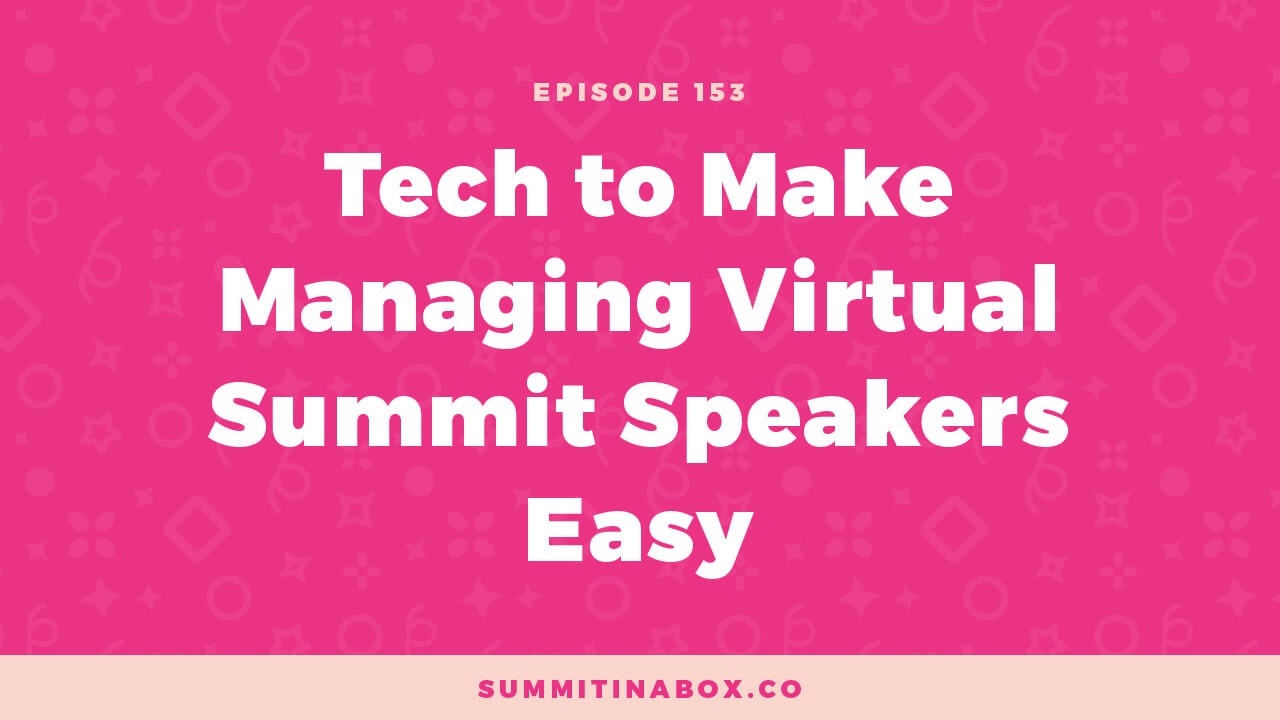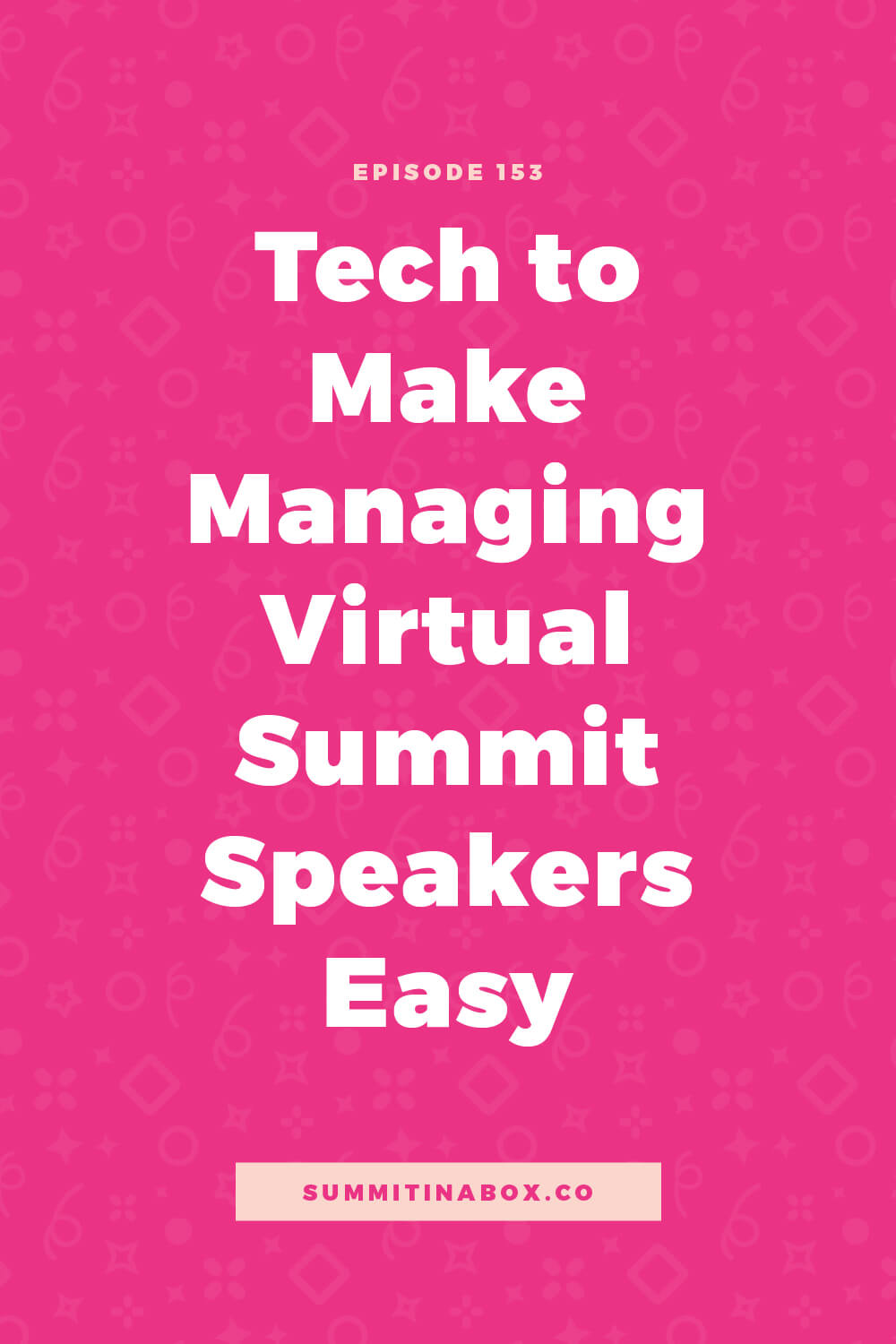Tech to Make Managing Virtual Summit Speakers Easy


The right tech tools have a big part to play in how easy it is to manage your speakers. Because, let's be real, trying to get material from 20+ people by a certain deadline can get a little scary.
Today, we'll break down the tools you need and I'll share my top recommendations. We'll cover everything you need from initial speaker outreach to creating presentations.
Some links used in this post are affiliate links.
Virtual Summit Speaker Management Tech
There are many moving parts when reaching out to and onboarding your virtual summit speakers. To keep it all organized, you'll want to work with a few key pieces of tech.
The main pieces of tech you’ll need for managing your speakers are:
- an email platform
- a way to collect material from them
- a way to follow-up
- tech for signing contracts
- scheduling calendar
- tech to conduct interviews (if you'll use the interview format)
Let's break it all down!
Speaker Organization
Let’s start with the speaker-related organization which is when you gather speaker names and keep track of who you pitch along with their responses.
Airtable makes it easy to have different views and filters based on who said yes, who hasn’t answered, who needs follow-up, and more.
You can also create separate views for each member of your team based on what information they need access to. For example, you can create a view solely for your designer to have the name, headshot, and presentation title so they can easily pull the information to create promotional graphics.
Our Summit in a Box program contains a full Airtable template to track everything from speaker brainstorming to where each speaker is at in the process to affiliate payouts after all is said and done.
Speaker Outreach
Next, let’s cover your speaker outreach which is when you send pitch emails. This one is nice and easy - use what you already have, such as Gmail, to send and reply to emails.
Don’t use your email service provider because an Unsubscribe link at the bottom of your email will be a turn-off for speakers, showing that you couldn't take the time to customize your pitch to them.
To make it easier, load canned responses, with your pitch and follow-up emails that you can customize and send to each person.
You can also use a tool called MailTrack when you send pitches to track who opens emails. It’s helpful to know if a speaker hasn’t received your pitch or chose to not respond. (Check out my tips on how to follow-up with speakers after pitching here.)
Virtual Summit Speaker Onboarding
Next, let's move on to speaker onboarding. Once you pitch a speaker and they agree to speak at your event, it’s time to gather information from them.
For example, the first group of information to gather is anything you need to finish off your summit website. This might include:
- headshot
- bio
- name
- presentation title
I’ve seen hosts ask for this via email but that can get messy and it’s best to ask speakers to fill out a form to gather everything you need from them.
Tech Options
If you have an organized place to put the information from your speakers, you will save time and headaches.
My two recommendations are:
- Airtable – This is a free option, and everything can load into your speaker tracking tables from your outreach and organization earlier.
- Content Snare – This is an awesome paid option, and if you reach out and let them know you’re a summit host, they will 2x your requests on their Startup plan without any additional costs.
Speaker Follow-Up
The next step of onboarding speakers is the follow-up. It’s common for speakers to not send what you need on time, especially if you don't send reminders.
You can manually follow-up yourself or use Content Snare to automate all of the follow-ups with templates and a schedule you create.
Related: Find out how to get speaker content on time and make it easy.
Speaker Contracts
The last piece of software you need for onboarding your speakers is something for contracts. I do recommend you have contracts with your speakers and for that, you can use whatever you’ve used for clients or a tool such as:
Ongoing Communication with Speakers
After your speakers are onboarded, then you have ongoing communication with them. Keep your speakers updated with what’s going on, keep it fun, and make sure the summit stays at the top of their minds.
I use my regular Gmail account to communicate, but I’ve seen many hosts use their email marketing platform with a specific tag or segment for their speakers to send a mass update.
Eden Fried, host of the Rebel Boss Summit, gets fancy and includes her speaker’s unique affiliate links every time she sends an email with a custom field.
The reason I personally use my regular Gmail account is that I'm someone who filters my inbox based on the word “unsubscribe”and I don't want speakers to miss my emails because of something like that.
Document Sharing
Also, for ongoing communication, document sharing comes into play. You need to share your promotional materials, like graphics and swipe copy. Your speakers will also need somewhere to upload their presentations.
I recommend using Google Drive for that. You could also use Dropbox, but I love how easy Google Drive is to use and get the exact links you want.
Speaker Interviews
Next, let’s cover the tech you need for speaker interviews. Usually, I do prerecorded presentations for my summits, but if you’re going to do interviews, the first thing you need is a tool to schedule the interviews.
Scheduling interviews
I recommend Acuity for scheduling. I also recommend that you have a specific calendar just for your speakers with different availability than your clients.
Include a custom form for them to fill out when they book their time to include things like preferred talking points or unique info about them to use in the intro.
Calendly is another option I’ve seen hosts use for scheduling speaker interviews, but I've never used it myself.
Conducting Interviews
The next pieces of tech are for conducting the interviews. (Check out the keys to engaging speaker interviews here.)
When choosing the tech to use, keep in mind:
- the ease of use for you and your speaker
- the video quality
- how reliable the tool is
I've used Zoom in the past, but the quality isn't that great. StreamYard is the top recommendation from the Summit Host Hangout Facebook group so it's what I'll be trying out next time.
Collecting presentations
The last category of tech you’ll need for managing your speakers is a tool to collect their presentations. You don’t need anything new for this and speakers can submit their presentations through a form like they did when giving their basic information.
I use Content Snare, but Airtable is a great alternative if you don’t mind doing the follow-up manually. Have speakers upload their presentation videos themselves to either Google Drive or Dropbox.
Choose Your Tech
Decide what you’ll use for collecting speaker information and get that decision out of the way!
Resources
- Airtable
- MailTrack
- Content Snare
- Dubsado
- HelloSign
- Google Drive
- Dropbox
- StreamYard
- Acuity
- Calendly
- Zoom
- Episode 67: How To Get Speaker Content On Time (And Make It Easy)
- Episode 133: Keys to Engaging Summit Speaker Interviews
- Episode 134: How to Follow-Up with Virtual Summit Speakers After Pitching
- Summit Host Hangout Facebook group
Pin it for later!



5-Minute Virtual Summit Roadmap
The 5-Minute Summit Roadmap leads you through the 7 essential questions that will guide the rest of your summit planning process and help you finally start making meaningful progress toward a profitable event.

